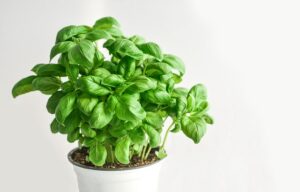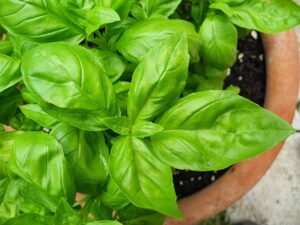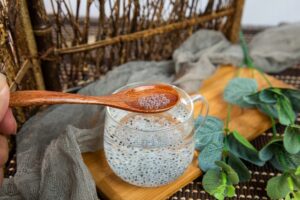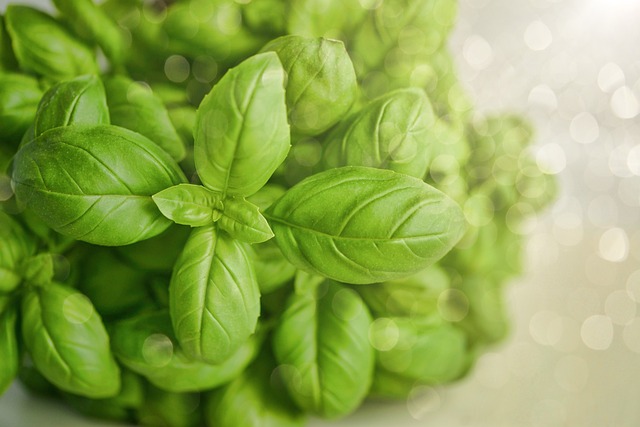Basil, a versatile and aromatic herb, is a favorite in kitchens worldwide. Growing basil at home offers the satisfaction of nurturing a plant and the convenience of having fresh leaves at your fingertips for culinary use. Whether you’re interested in traditional soil methods, container gardening, or innovative hydroponic systems, this guide will provide detailed instructions on growing basil successfully in various settings.

Understanding Basil Varieties
Before you start growing basil, choosing the right variety for your needs is essential. Here are some popular types of basil:
1. Sweet Basil: The most common type used in Italian cuisine, known for its sweet and slightly peppery flavour.
2. Thai Basil: Has a distinct anise-like flavour and is commonly used in Asian dishes.
3. Genovese Basil: A type of sweet basil with large, tender leaves, perfect for making pesto.
4. Lemon Basil: Features a citrusy aroma and flavour, ideal for adding a fresh twist to salads and fish dishes.
5. Purple Basil: Known for its deep purple leaves and mild flavour, often used as a garnish.
Growing Basil: General Guidelines
Soil and Location
Basil thrives in well-drained, fertile soil with a pH between 6.0 and 7.5. Choose a sunny location that receives at least 6-8 hours of direct sunlight daily.
Planting Basil
1. Seeds or Seedlings: You can start basil from seeds or purchase young plants from a nursery. If starting from seeds, sow them indoors 6-8 weeks before the last frost date.
2. Spacing: Plant basil 12-18 inches apart for adequate air circulation and growth.
Watering
Basil prefers consistent moisture but does not tolerate waterlogged soil. Water the plants when the top inch of soil feels dry, and ensure proper drainage to prevent root rot.
Fertilizing
Feed basil with a balanced, organic fertilizer every 4-6 weeks. Over-fertilizing can lead to excessive leaf growth with less flavor, so moderation is key.
How to Grow Basil Indoors Successfully

Growing basil indoors is a great way to ensure a year-round supply of fresh leaves. Follow these steps for indoor cultivation:
Choosing a Container
Select a pot with good drainage holes. A container with a diameter of at least 6-8 inches is ideal for a single basil plant.
Soil Mix
Use a high-quality potting mix with added perlite or vermiculite to improve drainage.
Light Requirements
Place the basil pot in a south-facing window where it can receive 6-8 hours of sunlight daily. If natural light is insufficient, supplement with fluorescent grow lights or LED lights, placing them 6-12 inches above the plants.
Watering
Indoor basil needs regular watering. Keep the soil consistently moist but not soggy. Water when the top inch of soil feels dry, and ensure excess water drains out.
Humidity and Temperature
Basil thrives in warm temperatures (70-80°F) and moderate humidity. If the indoor air is dry, increase humidity by placing a tray of water near the plants or using a humidifier.
How to Grow Basil at Home: Outdoor Gardening
Preparing the Garden Bed
1. Location: Choose a sunny spot with well-drained soil.
2. Soil Preparation: Amend the soil with compost or well-rotted manure to improve fertility and drainage.
Planting
1. Direct Sowing: Sow basil seeds directly into the garden bed after the last frost date. Cover seeds lightly with soil and water gently.
2. Transplanting Seedlings: Harden off indoor-grown seedlings by gradually exposing them to outdoor conditions for a week before planting.

Care and Maintenance
1. Watering: Water basil regularly, aiming for consistent soil moisture.
2. Mulching: Apply mulch around the plants to retain moisture and suppress weeds.
3. Pruning: Pinch off the top leaves regularly to encourage bushy growth and prevent flowering, which can reduce leaf flavor.
How to Grow Basil in a Pot
Container Selection
Choose a pot with a diameter of at least 6-8 inches for a single plant. Ensure the pot has drainage holes to prevent waterlogging.
Soil Mix
Use a well-draining potting mix enriched with organic matter. Avoid garden soil, which can be too dense for container gardening.
Planting
1. Seeds: Sow seeds directly into the pot, covering them lightly with soil.
2. Seedlings: Transplant seedlings into the pot, ensuring the roots are well-covered with soil.
Placement and Care
1. Light: Place the pot in a location that receives 6-8 hours of sunlight daily.
2. Watering: Water the pot regularly, keeping the soil moist.
3. Fertilizing: Feed the basil with a balanced, organic fertilizer every 4-6 weeks.
How to Grow Basil Hydroponically
Hydroponic systems allow you to grow basil without soil, using a nutrient-rich water solution. Here’s how to set up a hydroponic system for basil:
Choosing a Hydroponic System
1. Nutrient Film Technique (NFT): This system uses a shallow stream of nutrient solution flowing over the roots.
2. Deep Water Culture (DWC): Plants are suspended in a nutrient solution with their roots submerged.
3. Aeroponics: Roots are suspended in the air and misted with a nutrient solution.
Setting Up the System
1. Container: Use a reservoir to hold the nutrient solution.
2. Net Pots: Place basil seedlings in net pots filled with an inert growing medium like hydroton or rock wool.
3. Nutrient Solution: Mix a hydroponic nutrient solution according to the manufacturer’s instructions.
Planting and Maintenance
1. Planting: Place the net pots with seedlings into the hydroponic system.
2. Light: Provide 12-16 hours of artificial light daily using LED grow lights.
3. Monitoring: Regularly check the pH (maintain between 5.5 and 6.5) and nutrient levels of the solution.
4. Aeration: Ensure proper oxygenation of the nutrient solution using an air pump and air stones.
Harvesting
1. When to Harvest: Begin harvesting basil leaves once the plant has at least 6-8 sets of leaves.
2. How to Harvest: Pinch off the leaves from the top down, encouraging new growth and prolonging the plant’s life.
Troubleshooting Common Issues
Pests
1. Aphids: Small, sap-sucking insects that can cause stunted growth. Control with insecticidal soap or neem oil.
2. Spider Mites: Tiny pests that cause webbing and yellowing leaves. Increase humidity and use miticides if necessary.
Diseases
1. Downy Mildew: Fungal disease that causes yellowing and browning of leaves. Improve air circulation and avoid overhead watering.
2. Fusarium Wilt: A soil-borne disease causing wilting and yellowing. Use disease-resistant varieties and rotate crops.
Poor Growth
Ensure the basil receives adequate light, water, and nutrients. Avoid overcrowding and provide sufficient space for each plant.
Conclusion
Growing basil at home, whether indoors, outdoors, in pots, or hydroponically, is a fulfilling and practical endeavour. By following the guidelines outlined in this comprehensive guide, you can ensure a bountiful harvest of this aromatic herb, enhancing your culinary creations with fresh, home-grown basil. Happy gardening!

